
Backgammon Rulebook
This is a backgammon rulesbook.
Introduction
Backgammon is one of the oldest known board games, originating from the "tables" family of games that date back millennia. The modern game took shape in 17th-century England, evolving from earlier versions like the game of Irish.
It is a two-player board game that combines strategy and luck, played with dice and 15 pieces per player on a board of 24 points. The objective of backgammon is to move all of your fifteen checkers around the board and eventually bear them off (remove them from the board) before your opponent does. A player who bears off all their pieces first wins the game. Achieving this while the opponent has not borne off any checkers yields higher scoring outcomes like a gammon or backgammon.
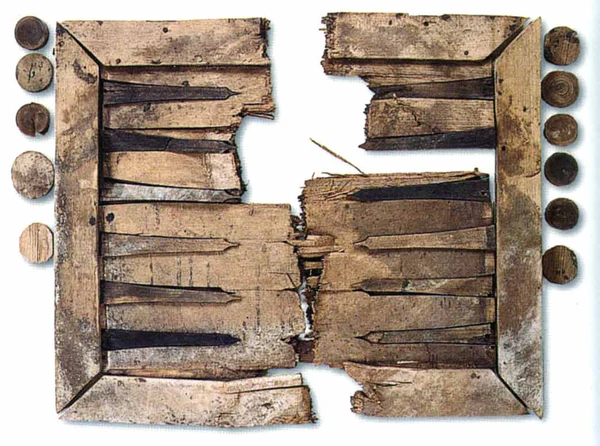

You can learn Backgammon in an interactive way, following this tutorial
Setup
Backgammon is played on a rectangular board divided into four quadrants, each containing six narrow triangles known as points. The points alternate in color and are numbered 1 through 24 for each player, with each player counting in opposite directions. Each player has their own home board (points 1-6) and outer board (points 7-12); your home board is your opponent’s far side, and vice versa.
Each player starts with 15 checkers, plus a pair of six-sided dice, a dice cup, and a special doubling cube marked with 2, 4, 8, 16, 32, and 64. The initial arrangement places two checkers on the 24-point, five on the 13-point, three on the 8-point, and five on the 6-point. The doubling cube is placed in the center with 64 facing up, indicating the game is at 1× stake.

Basic Rules
To determine who goes first, each player rolls one die. The player who rolls higher uses both dice for the first move. If there is a tie, roll again. After the first turn, each player rolls two dice at the start of their turn.
The numbers on the dice can be split between two different checkers or applied to a single checker, provided each partial move is to an open point. Both dice must be used if possible; if only one can be used, it must be. If neither can be used, the player forfeits the turn. Doubles grant four moves of that value. You cannot land on a point occupied by two or more enemy checkers.
Hitting and Entering
A single checker on a point is a blot. If an opponent’s checker lands on that blot, it is hit and placed on the bar. Checkers on the bar must be re-entered into the opponent’s home board before any other moves are made.
To re-enter, roll the dice and use one or both values to bring the checker in on a corresponding point. If all entry points are blocked, you lose that turn. If you can enter at least one checker, you must do so; if you cannot enter them all, any remaining checkers stay on the bar until your next turn.
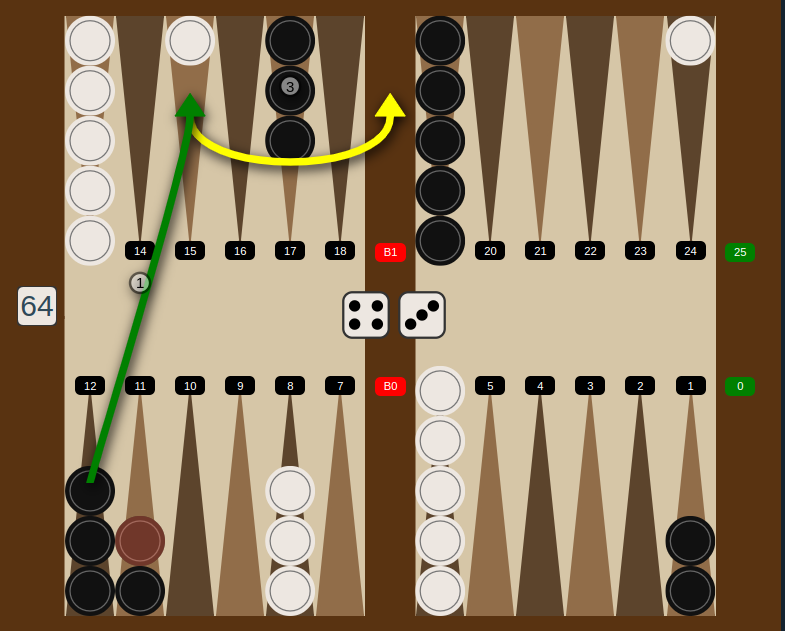
Bearing Off
Once all 15 checkers are in your home board, you may start bearing them off. A checker can be borne off by rolling a number equal to the point where it resides. Rolling a higher number than your highest occupied point lets you bear off from the highest point.
You are not required to bear off a checker if you can make another legal move. However, if no other moves are available, you must bear off. If a checker is hit and sent to the bar during bearing off, you must re-enter it and bring it back to your home board before continuing to bear off.
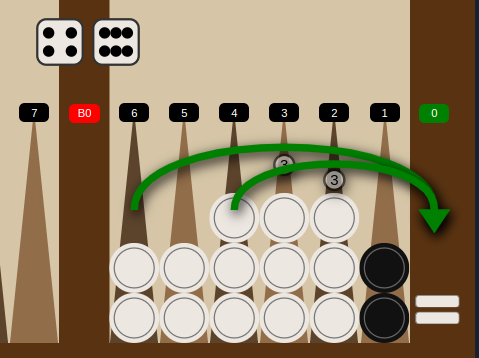
Doubling Cube
The doubling cube is marked with 2, 4, 8, 16, 32, and 64. At the start of the game, it is centered, effectively at 1×. Only on your turn, before rolling the dice, can you offer a double. Your opponent may accept or decline.
If declined, the game ends and the decliner loses at the current stake. If accepted, the stakes double, and the cube moves to the acceptor’s side. Only the new owner may redouble later. The cube can be used multiple times per game, each time doubling the stakes.
Scoring
A single win (when both players have borne off at least one checker) is worth the cube’s current value. A gammon (opponent has not borne off any checkers) is worth twice the cube’s value. A backgammon (opponent has no checkers borne off and still has one on the bar or in your home board) is worth three times the cube’s value.
These results matter for match play (adding points toward a target score) or money play (translating points to monetary stakes). Offering or accepting doubles, along with trying to avoid being gammoned or backgammoned, greatly impacts strategy.
You can learn Backgammon in an interactive way, following this tutorial
Common Strategies
Common approaches include running games (aiming to race off quickly), holding games (keeping anchors in the opponent’s territory), priming (building consecutive points to block the opponent), blitzing (hitting and trapping the opponent’s checkers on the bar), and backgames (holding multiple anchors deep in the opponent’s home board for a late reversal).
Skills like diversification (spreading out checkers to increase flexibility), duplication (forcing the opponent to need the same roll for multiple goals), and correct cube handling are vital. Strategy often shifts dynamically as dice rolls change the board.

Variations
Backgammon has many variants, including Acey-Deucey, where a roll of 1-2 grants extra moves, Nackgammon, which starts with four checkers on the 24-point, and Hypergammon, where each player has only three checkers. While core rules remain similar, these variants alter the starting setup or special actions.
Other variations like Russian Backgammon or Longgammon have different starting positions and movement rules. Some involve different scoring or doubling rules. Chouette is a multi-player format where a single ‘box’ competes against a team.
The most iconic variant so far is Abak Evolution. Abak adds classes of checkers for each team, creating a chess-feeling version of the game wich is more complex and strategic, with a slightly higher strategy/luck ratio

Official Tournament Rules
Tournament play typically follows the same basic rules but adds guidelines for fair dice rolling, corrections of illegal moves, match scoring, and the Crawford rule. The Crawford rule states that when a player is one point away from winning a match, the next game is played without the cube.
Players must roll dice using cups and possibly baffle boxes, and cocked dice or premature rolls are re-rolled. Illegal moves can be corrected if noticed before the opponent rolls. Etiquette rules also apply, and disputes are resolved by a tournament director.
Conculsion
Backgammon’s blend of luck and strategy, along with the excitement of the doubling cube, makes it a compelling game for beginners and experts alike. By understanding these rules, scoring, and strategies, you can dive into the timeless enjoyment of backgammon.
Whether you are playing casually, in a money game, or at a tournament, the fundamentals remain the same. Enjoy your journey into this centuries-old classic!
You can learn Backgammon in an interactive way, following this tutorial









